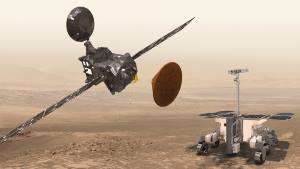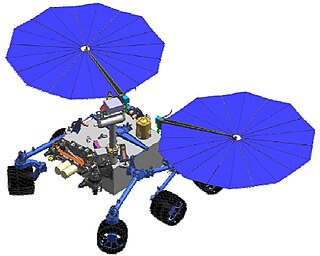Related Research Articles
A biosignature is any substance – such as an element, isotope, molecule, or phenomenon that provides scientific evidence of past or present life. Measurable attributes of life include its complex physical or chemical structures, its use of free energy, and the production of biomass and wastes. A biosignature can provide evidence for living organisms outside the Earth and can be directly or indirectly detected by searching for their unique byproducts.

ExoMars is an astrobiology programme of the European Space Agency (ESA) and the Russian space agency (Roscosmos).

The Astrobiology Field Laboratory (AFL) was a proposed NASA rover that would have conducted a search for life on Mars. This proposed mission, which was not funded, would have landed a rover on Mars in 2016 and explore a site for habitat. Examples of such sites are an active or extinct hydrothermal deposit, a dry lake or a specific polar site.

Mawrth Vallis is a valley on Mars, located in the Oxia Palus quadrangle at 22.3°N, 343.5°E with an elevation approximately two kilometers below datum. Situated between the southern highlands and northern lowlands, the valley is a channel formed by massive flooding which occurred in Mars’ ancient past. It is an ancient water outflow channel with light-colored clay-rich rocks.

The ExoMars Trace Gas Orbiter is a collaborative project between the European Space Agency (ESA) and the Russian Roscosmos agency that sent an atmospheric research orbiter and the Schiaparelli demonstration lander to Mars in 2016 as part of the European-led ExoMars programme.

Northern Light was a concept mission for a robotic mission to Mars that would consist of a lander and a rover, being studied by a consortium of Canadian universities, companies and organisations. The primary contractor for the spacecraft was Thoth Technology Inc.

The Mars Astrobiology Explorer-Cacher (MAX-C), also known as Mars 2018 mission, was a NASA concept for a Mars rover mission, proposed to be launched in 2018 together with the European ExoMars rover. The MAX-C rover concept was cancelled in April 2011 due to budget cuts.
Rosalind Franklin, previously known as the ExoMars rover, is a planned robotic Mars rover, part of the international ExoMars programme led by the European Space Agency and the Russian Roscosmos State Corporation. The mission was scheduled to launch in July 2020, but was postponed to 2022. The Russian invasion of Ukraine has caused an indefinite delay of the programme, as the member states of the ESA voted to suspend the joint mission with Russia; in July 2022, ESA terminated its cooperation on the project with Russia. As of May 2022, the launch of the rover is not expected to occur before 2028 due to the need for a new non-Russian landing platform.
The Biological Oxidant and Life Detection (BOLD) is a concept mission to Mars focused on searching for evidence or biosignatures of microscopic life on Mars. The BOLD mission objective would be to quantify the amount of hydrogen peroxide existing in the Martian soil and to test for processes typically associated with life. Six landing packages are projected to impact 'softly' on Mars that include a limited power supply, a set of oxidant and life detection experiments, and a transmitter, which is able to transmit information via an existing Mars orbiter back to Earth. The mission was first proposed in 2012.
The PanCam assembly is a set of two wide angle cameras for multi-spectral stereoscopic panoramic imaging, and a high resolution camera for colour imaging that has been designed to search for textural information or shapes that can be related to the presence of microorganisms on Mars. This camera assembly is part of the science payload on board the European Space Agency'sRosalind Franklin rover, tasked to search for biosignatures and biomarkers on Mars. The rover is planned to be launched in August–October 2022 and land on Mars in spring 2023.
ExoLance is a low-cost mission concept that could hitch a ride on other missions to Mars in an effort to look for evidence of subsurface life.
The Mars Organic Molecule Analyser (MOMA) is a mass spectrometer-based instrument on board the Rosalind Franklin rover to be launched in 2028 to Mars on an astrobiology mission. It will search for organic compounds in the collected soil samples. By characterizing the molecular structures of detected organics, MOMA can provide insights into potential molecular biosignatures. MOMA will be able to detect organic molecules at concentrations as low as 10 parts-per-billion by weight (ppbw). MOMA examines solid crushed samples exclusively; it does not perform atmospheric analyses.

MicrOmega-IR is an infrared hyperspectral microscope that is part of the science payload on board the European Rosalind Franklin rover, tasked to search for biosignatures on Mars. The rover is planned to be launched not earlier than 2028. MicrOmega-IR will analyse in situ the powder material derived from crushed samples collected by the rover's core drill.
Raman Laser Spectrometer (RLS) is a miniature Raman spectrometer that is part of the science payload on board the European Space Agency'sRosalind Franklin rover, tasked to search for biosignatures and biomarkers on Mars. The rover is planned to be launched not earlier than 2028 and land on Mars in 2029.
Infrared Spectrometer for ExoMars (ISEM) is an infrared spectrometer for remote sensing that is part of the science payload on board the European Space Agency'sRosalind Franklin rover, tasked to search for biosignatures and biomarkers on Mars. The rover is planned to be launched not earlier than 2028 and land on Mars in 2029.
ADRON-RM is a neutron spectrometer to search for subsurface water ice and hydrated minerals. This analyser is part of the science payload on board the European Space Agency'sRosalind Franklin rover, tasked to search for biosignatures and biomarkers on Mars. The rover is planned to be launched not earlier than 2028 and land on Mars in 2029.
WISDOM is a ground-penetrating radar that is part of the science payload on board the European Space Agency'sRosalind Franklin rover, tasked to search for biosignatures and biomarkers on Mars. The rover is planned to be launched not earlier than 2028 and land on Mars in 2029.
CLUPI is a miniaturized camera system on board the planned European Space Agency Rosalind Franklin rover. CLUPI was designed to acquire high-resolution close-up images in colour of soils, outcrops, rocks, drill fines and drill core samples, as well as and the search for potential biosignature structures and patterns. This camera assembly is part of the science payload on board the European Space Agency'sRosalind Franklin rover, tasked to search for biosignatures and biomarkers on Mars. The rover is planned to be launched not earlier than 2028 and land on Mars in 2029.
Nadir and Occultation for MArs Discovery (NOMAD) is a 3-channel spectrometer on board the ExoMars Trace Gas Orbiter (TGO) launched to Mars orbit on 14 March 2016.
Signs Of LIfe Detector (SOLID) is an analytical instrument under development to detect extraterrestrial life in the form of organic biosignatures obtained from a core drill during planetary exploration.
References
- ↑ Vago, Jorge L.; et al. (July 2017). "Habitability on Early Mars and the Search for Biosignatures with the ExoMars Rover". Astrobiology. 17 (6–7): 471–510. Bibcode:2017AsBio..17..471V. doi:10.1089/ast.2016.1533. PMC 5685153 . PMID 31067287.
- ↑ Howell, Elizabeth (July 24, 2018). "ExoMars: Searching for Life on Mars". Space.com . Retrieved March 13, 2020.
- 1 2 Ma_MISS on ExoMars: Mineralogical Characterization of the Martian Subsurface. Maria Cristina De Sanctis, Francesca Altieri, Eleonora Ammannito, David Biondi, Simone De Angelis, Marco Meini, Giuseppe Mondello, Samuele Novi, Riccardo Paolinetti, Massimo Soldani, Raffaele Mugnuolo, Simone Pirrotta, Jorge L. Vago. Astrobiology, Vol. 17, No. 6-7. 1 July 2017. doi : 10.1089/ast.2016.1541.
- 1 2 3 The ExoMars Rover Instrument Suite: Ma_MISS - Mars Multispectral Imager for Subsurface Studies. European Space Agency. Accessed: 20 July 2018.
- 1 2 3 4 5 VNIR spectral measurements on rock slabs with ExoMars Ma_Miss instrument. S. De Angelis, M.C. De Sanctis, E. Ammannito, C. Carli, T. Di Iorio, A. Frigeri, P. Manzari. EPSC Abstracts. Vol. 9, EPSC2014-243, 2014. European Planetary Science Congress 2014.
- 1 2 3 MA_MISS: Mars Multispectral Imager for Subsurface Studies. De Sanctis, M. C.; Coradini, A.; Ammannito, E.; Boccaccini, A.; Di Iorio, T.; Battistelli, E.; Capanni, A. EGU General Assembly 2012, held 22-27 April, 2012 in Vienna, Austria. pg. 6592.
- ↑ MA MISS: Mars Multispectral Imager for Subsurface Studies. (PDF) A. Coradini, G. Piccioni, etal. Adv. Space Res. Vol. 28, No. 8, pp. 1203-1208, 2001.
- 1 2 "The ExoMars Rover Instrument Suite". exploration.esa.int. Retrieved 2018-07-21.
